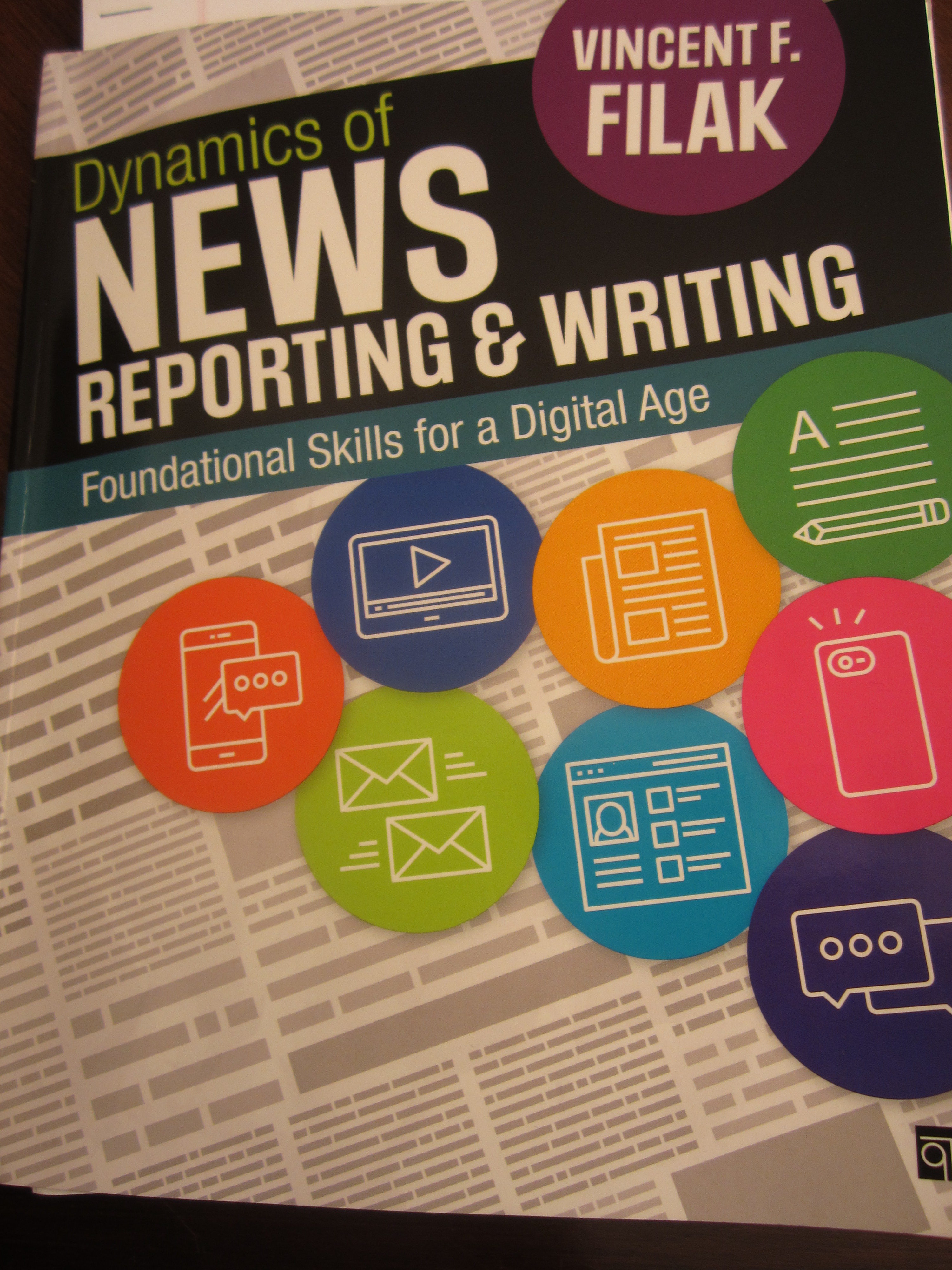Filak’s textbook offers ‘more’ in form of accompanying blog
Reviewed by Carolyn Schurr Levin
 At a time when students are increasingly skeptical about the value of high priced textbooks and professors are often asked to justify their cost, it undoubtedly helps when a book offers something “more.” Vincent Filak’s “Dynamics of News Reporting & Writing,” released on Jan. 2, 2018, does just that. In addition to providing a potpourri of chapters routinely found in reporting books, including “Interviewing,” “Broadcast-Style Writing and Voicing,” “Basics of Writing,” and “Editing Audio and Video,” Filak, a professor of journalism at the University of Wisconsin Oshkosh, has deftly added “more” in the form of a blog, dynamicsofwriting.com. It includes almost daily updates with additional information, examples of material discussed in the textbook and interactive elements to keep students engaged and the material fresh. Recent blog posts, including “Profile Writing: You can observe a lot by watching” and “5 cool things about open records I learned from an #ACPBOM session,” provide timely and helpful content that can be integrated into a course curriculum.
At a time when students are increasingly skeptical about the value of high priced textbooks and professors are often asked to justify their cost, it undoubtedly helps when a book offers something “more.” Vincent Filak’s “Dynamics of News Reporting & Writing,” released on Jan. 2, 2018, does just that. In addition to providing a potpourri of chapters routinely found in reporting books, including “Interviewing,” “Broadcast-Style Writing and Voicing,” “Basics of Writing,” and “Editing Audio and Video,” Filak, a professor of journalism at the University of Wisconsin Oshkosh, has deftly added “more” in the form of a blog, dynamicsofwriting.com. It includes almost daily updates with additional information, examples of material discussed in the textbook and interactive elements to keep students engaged and the material fresh. Recent blog posts, including “Profile Writing: You can observe a lot by watching” and “5 cool things about open records I learned from an #ACPBOM session,” provide timely and helpful content that can be integrated into a course curriculum.
The textbook is written in a conversational tone. “I try to put tools in your toolbox,” Filak said. “Whatever you are doing or where you are going, you will take these with you.” The book is, above all, practical and user friendly. Each chapter begins with “Learning Objectives,” offers “Helpful Hints,” and ends with “Write Now!” assignments.
Filak has reversed the process of how reporting is usually taught. “You must understand your audience first and foremost,” he said. “You don’t own the audience anymore; the audience owns you.” His book is intended to be audience-centric. Indeed, Chapter 1 is titled “Audience-Centric Journalism,” with a stated learning objective of understanding “what makes today’s readers different from news consumers in prior generations and how best to serve them based on those differences.” It is not an overstatement to say that the concepts he addresses in Chapter 1 – fake news, info glut, shorter attention spans, and spiraling viral coverage – are critical to the future of journalism education and journalism itself. Filak implores students to ask what they know about their audience and what their audience needs to know. His “Big Three” at the end of Chapter 1 are: “The audience matters most,” “Journalists owe the audience,” and “Focus on the interest elements.”
One of the other special features about “Dynamics of News Reporting & Writing” is the chapter on “Critical Thinking.” How to teach critical thinking skills is something that many journalism professors grapple with routinely. Filak seems to understand this well. Getting the story, he writes, “means more than picking up facts and quotes as if they were items on a grocery list that you simply toss into your cart.” He offers highly practical advice on how to approach a story as a critical thinker, including the fundamental importance of preparation. “If you take the skills you learn and apply a heavy dose of critical thinking with regard to how best to tell a story and how to reach your audience, you will be successful in this business,” he earnestly states in the book’s Preface.
In addition to Filak’s blog, the book’s publisher, Sage Publishing, offers an online study site complete with practice quizzes, eflashcards, assignments and exercises. With all of the supplemental materials available with this new textbook, one may in fact wonder when students will have time to actually report and write stories.
And, if all of that isn’t enough, Filak adds an appendix on resumes, cover letters and more. The appendix, written in the first person, offers helpful tips on resume building, cover letter writing, the job application process, and even negotiating a job offer. Other appendices to the textbook offer step-by-step editing processes for Avid, Final Cut and Premier, and a FOIA and state records primer.
Filak is a prolific author of communications and media textbooks. His “Dynamics of Media Writing” was published in 2015 and a second edition is already in the works for next fall. “Dynamics of Media Writing” was reviewed for CMR by Lindsey Wotanis in January 2016. Although there is conceptual overlap in Filak’s media writing book and his new one, the reporting book is meant specifically for news reporting classes and the media writing book is intended to have a broader reach for public relations and other communications-related disciplines. Filak is also already working on a new book, an editing textbook that will be released in the near future.
Filak teaches media writing, reporting, feature writing and assorted other undergraduate classes. He understands well the pitfalls and perils of teaching journalism classes. His goal is to partner with the professors using his books in their classes, as opposed to just being “a name on a spine.” He is eager to add content requested by professors to his continually updated blog. One professor asked for material on freelancers, and Filak accommodated the request with in depth interviews and blog posts about freelancers. In this way, he enthusiastically personalized his new book for his users. That should be an easy sell for professors and students who want the latest material. This new textbook meets the promise of its title and is truly “dynamic.”

About the Author: Carolyn Schurr Levin, an attorney specializing in Media Law and the First Amendment, is a professor of journalism and the faculty adviser for the student newspaper at Long Island University, LIU Post. She is also a lecturer and the media law adviser for the Stony Brook University School of Journalism. She has practiced law for over 25 years, including as the Vice President and General Counsel of Newsday and the Vice President and General Counsel of Ziff Davis Media.

One thought on “Review: ‘Dynamics of News Reporting & Writing’”
Comments are closed.